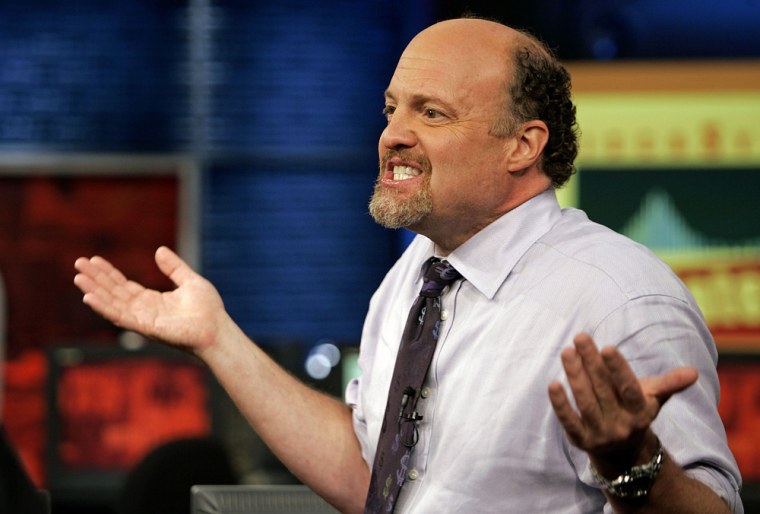One screams and throbs at the camera, while the other would address his viewers with the wooden calm of an English gentleman at tea time.
Yet despite the Jekyll-and-Hyde differences between Jim Cramer and the late Louis Rukeyser, there’s one notable similarity between their TV programs: any mention of a company could move its stock.
This is a crucial fact for individual investors to understand because the stock market is a crafty place where the smart money loves to prey on predictable patterns like the instant bounce for stocks touted by Cramer on CNBC’s “Mad Money” program. And when the pros win, the ordinary folk are bound to lose.
(CNBC is operated by NBC Universal. MSNBC is a joint venture of Microsoft and NBC.)
Cramer fans needn’t despair. Rather than swearing off the former hedge fund manager’s advice, all that may be required is the poise and patience to wait a couple of weeks before putting your money where his mouth is, judging from a study into trading patterns after each airing of Mad Money on weekday nights. Cramer himself urges viewers to avoid the temptation to rush right in, especially during after-hours trading, though he doesn’t see a need to hold off for weeks.
Investors flock to Cramer’s show for good reason. It’s rare for average investors to have direct access to a professional stock picker with Cramer’s vast knowledge and experience. That’s why shows like his have the effect they do, and why caution is advisable.
There was a time, before the Internet, where it was hard to get stock and bond quotes, let alone timely advice from the pros. One easily accessible resource was the weekly edition of Barron’s. Even more accessible to the masses was Rukeyser’s long-running “Wall Street Week,” which appeared once a week, free of charge, on PBS.
Since Barron’s came out on the weekend and Rukeyser’s show generally ran on Friday nights, there was an entire weekend to mull the information imparted by the money managers and investment analysts featured in either venue. Invariably, by Monday morning, the pent-up demand would push the touted names higher.
The pace has quickened dramatically since the mid-nineties, stoked by all-day market coverage and prognostication on CNBC, countless Web sites and frothy online message boards.
At the same time, technology has provided the computing power and sophistocated software to crunch all that real-time information in real time, enabling professionals to prowl for opportunities afforded by the market’s herd-like reactions.
With a stream of stock tips as steady and high-profile as Cramer’s, it doesn’t even take technology to see there’s a pattern to exploit. So for better or worse, it seems the pros are scoping out the joint when it comes to Mad Money, judging from an academic study into trading following each edition of program.
The study by Joseph Engelberg, Caroline Sasseville and Jared Williams — doctoral students at the Kellogg School of Management at Northwestern University — tracked the performance of about 250 companies that drew a favorable mention on Cramer’s evening program between late July and mid-October last year.
Overall, shares of the recommended companies outperformed the market by an average of 3.5 percent on the first day after Cramer’s tout. The smallest companies outperformed by 6.2 percent on average.
Almost immediately, however, the stocks beat a hasty retreat, surrendering the initial gains within about 12 days.
In tandem with this activity, the researchers found a sharp uptick in opportunistic behavior among short sellers, who sell borrowed shares with plans to buy them back at a lower price later, pocketing the difference. Starting with the next morning’s opening bell, short-selling in a Cramer-recommended stock spiked to six times the normal volume in the first few minutes of trading and then remained above average for three days.
Cramer told The Associated Press he repeatedly warns his audience to steer clear of after-hours trading, when he says buyers outnumber sellers, making it easier to get burned.
“The takeaway of show shouldn’t be whether you made money in a 24 hour period,” Cramer said. The study “basically agreed with what I say every night, which is ’Please wait. Please do your homework.’ There is a responsibility on people watching the show and there really isn’t a rush to buy things.” Still, Cramer also said he doesn’t see a need to wait much more than a day to act.
Importantly, the researchers didn’t pass any judgement on Cramer’s stock-picking prowess or concern themselves with the longer-term performance of the companies.
The main lesson is that those who believe Cramer’s insight is valuable may do themselves a favor by stepping back and waiting for the initial storm of activity to blow over. Any gains to be had with his recommendations will only be enhanced by avoiding a costly mad rush to follow the Mad Money.
